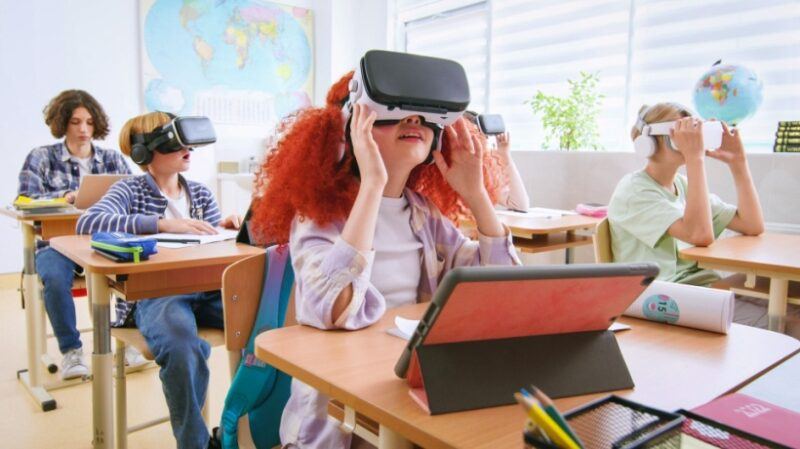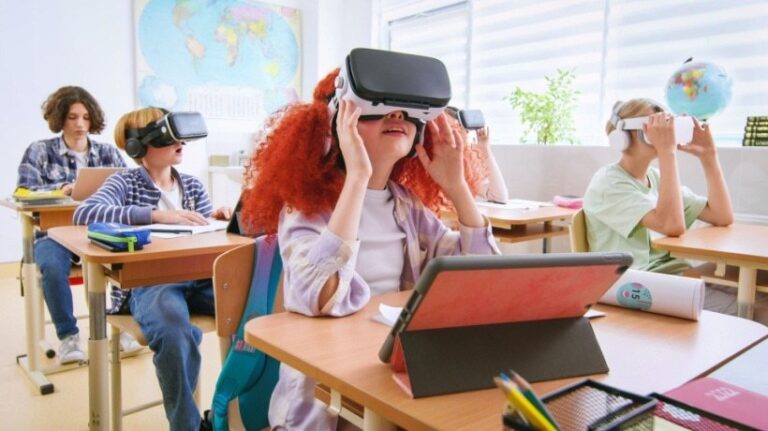
The role of immersive technology in e-learning
Immersive technology is changing the way people learn. In eLearning, immersive technology includes all the tools and experiences that go beyond screens and static content. You might think of virtual reality and augmented reality (VR/AR), but you’re right, but there are many more, like mixed reality (MR) and AI-driven simulations. All these technologies draw learners into an interactive 3D environment where they practice, explore and engage in real-world ways. Instead of reading textbooks or watching videos, learners can walk through virtual factories, handle digital versions of machines, and deal with practice skills such as negotiation and public speaking with realistic avatars.
This change is important. For learners, training is more engaging and memorable as it is more active than simply absorbing information. This increases retention rates as your brain remembers better experiences than texts. Additionally, an immersive environment allows learners to try to make mistakes without any real risks or costs. For example, medical students can practice surgery without injuring patients, and new recruits can explore the company’s workflow before using actual equipment. So immersive technology can be said to link theory and practice in ways that traditional e-learning cannot be done.
Organizations also provide great benefits. Instead of spending money on training costs such as facilities and transportation, you can provide virtual training that works with your team. This saves costs and ensures consistent training. Furthermore, AI and analytics from these platforms allow companies to collect valuable data on learner interactions, highlight their strengths, and identify areas in which employees need support. This information will help you improve your training programme and build stronger workforce skills. Overall, immersive technology is more than just a trend. They show that education and professional training are constantly improving to provide and create more engaging and effective experiences. Explore immersive techniques popular in eLearning and what to consider before implementing them.
6 Important Immersive Technological Trends in E-Learning
1. Virtual and Augmented Reality
Virtual and augmented reality make learning more engaging by turning abstract ideas into hands-on experiences. VR allows learners to enter an immersive environment as well as basic simulations. For example, you can wear a headset and step into a virtual chemistry lab. There you can experiment without risk. This gives them a safe space to practice making decisions under pressure. Meanwhile, AR adds digital elements to the real world, making learning interactive in a unique way. Instead of reading textbooks, students can explore historical events, scientific models, and even AR holograms that bring to life on their desks. AR also promotes teamwork by allowing groups to build and modify 3D models in real time, allowing classroom lessons to be connected to real applications.
Both technologies offer great benefits. While VR allows learners to practice real-life skills without risk, AR blends the digital world elements of the physical world and makes information easier to understand by turning e-learning into a more immersive, interactive and memorable experience than traditional methods.
2. Metaverse Learning Ecosystem
What if students could log in to a virtual campus and step into digital classrooms as an avatar? There, they can greet their classmates, chat with their instructors, and sit at their virtual desks all from home. This is what the Metaverse Learning Ecosystem does. They offer a shared virtual world created for education and training. You can have auditoriums, lounges and collaboration rooms where learners can brainstorm and build projects in real time. The best part is that once students log off, their avatars, projects and conversations stay in the metaverse. This will allow you to return to them at any time. The scenario is not overstated. Some universities have virtual campuses where students can participate in lectures, participate in clubs and become social online. Companies are also trying out the training metaverse. New employees can explore digital versions of their offices, meet mentors, and complete onboarding tasks in an interactive way.
Metaverse encourages social learning and gives learners a sense of community that is often missing in online courses. It also provides continuity, as you can log in and continue wherever you leave, right away. Furthermore, people from different countries and cultures are connected, and are not usually possible in traditional classrooms.
3. The reality of mixing and augmentation
We talked about how virtual reality brings you into a completely digital world, while augmented reality adds a digital element to the real world. But mixed reality combines the two. Digital and physical objects exist and can interact in real time. Currently, Augmented Reality (XR) is the overall term that includes VR, AR, and MR. For example, imagine engineers from different countries who wear headsets and can see and interact with the same 3D model of a new product as if they were right in front of them. Similarly, classrooms can enhance the physical classroom with interactive digital experiences that project the human mind into the room and make it easier to understand complex ideas.
The true power of MR and XR is the ability to teach skills that are difficult to learn from slides and textbooks. Thanks to these technologies, technical training is safer and more attractive. Plus, remote collaboration is now even easier and easier than ever. In short, Mr. and XR have people have people do, explore and cooperate with us, as if the digital and physics worlds were one seamless space.
4. AI and immersive technology
By combining AI with immersive technology in e-learning, students can enter virtual classrooms and meet avatars who understand how to learn. This will become their personal digital tutor. Instead of all taking the same course, AI-driven avatars can act as tutors, adapt to the pace, explain things differently when someone is struggling, and provide additional challenges when the learner is ready to move forward. This also offers plenty of real-time performance analysis opportunities. For example, if someone is training for sales in VR, the system tracks tone, body language, and confident speaking. They also receive feedback at the moment.
The exciting part of combining AI with immersive technology is the opportunity to create a personalized learning path. If someone learns the skills quickly, the system moves them first. If you need more time, it will be slower and will provide extra practice. In this way, learners stay motivated as they feel their journey is designed for them.
5. Gamification and Storytelling
Considering learning, I might paint textbooks, slides, and quizzes. But what if learning felt like playing games or being part of the story? That’s what gamification and storytelling do in an immersive environment, changing how people get involved in e-learning. Gameified Platform works like a mobile game. Learners earn points to complete tasks, ranked on leaderboards for friendly competition, unlock digital badges to show progress. Storytelling adds to this experience. In addition to seeing the content, learners will take part in stories that can make an impact. For example, employees who practice leadership skills in VR simulations can participate in stories where they have to make tough choices that impact their teams.
When gamification and storytelling work together, learners remain motivated and practice problem-solving, especially when working with peers. Teams work on challenges as characters in shared stories and build skills in both knowledge and teamwork.
6. Brain computer interface and neurotrophic learning
Brain-Computer Interfaces (BCIS) is a system that connects the brain directly to a digital platform, using small sensors to pick up brain activity. This may sound like something from a sci-fi movie, but technology is already in the early stages of development and could completely change e-learning. Here’s how it works: BCI devices can detect signals that reveal things like cognitive load. So, if someone’s brain is overloaded during an immersive training session, the system will notice. Instead of pushing them harder, the environment can then automatically slow down, repeat key points, and simplify tasks until the learner is ready to move forward. On the other hand, if the system sees the learner as finding things too easy, it can make the challenge even more difficult.
This is called “neuroadaptive learning.” It’s innovative because it means that training experiences literally adapt to our brains in real time. The potential benefits are huge. Learners can stay motivated rather than irritated, companies can reduce wasted training time, and educators can ensure no one is left behind. We are still in the early days, but BCI-led learning ultimately managed to create a truly comprehensive classroom and training program.
Conclusion
Immersive technology is changing the way we learn, making education more engaging, memorable and practical. When learners can interact with realistic simulations, explore virtual environments, and practice practical skills, they will remain focused longer and remember more. Additionally, it promotes real-world applications that prepare people for real challenges. Embracing immersive technology is no longer an option for organizations and educators. Those who invest in VR, AR, and other immersive technologies in eLearning empower learners and enhance their results.


